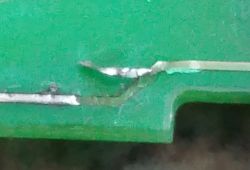

Czy wolisz polską wersję strony elektroda?
Nie, dziękuję Przekieruj mnie tamasdros wrote:you can't see it in your photos, so I enlarged it:

OldesMatuzalem wrote:First, you need to use a gently heated soldering iron tip - and, for example, with a medical needle (from a syringe) - to gently straighten the broken path and guide it to its proper place ...
tomek_602 wrote:You write some rubbish you write out with this 'whole evening' ...OldesMatuzalem wrote:First, you need to use a gently heated soldering iron tip - and, for example, with a medical needle (from a syringe) - to gently straighten the broken path and guide it to its proper place ...
But why so complicated?
You propose an entire evening of an artistic church room for the conservation reconstruction of the path, and the electricity will not appreciate it anyway.
All it takes is a piece of kynar from hole to hole.
tomek_602 wrote:associated with removing the solder mask grommet from the eyelet, which will DEFINITELY take longer than the above suggested repair method.a piece of kynar from hole to hole
Kraniec_Internetów wrote:Scratch off the solder mask (varnish) from the ends of the damaged fragment and solder a thin wire or a few there.